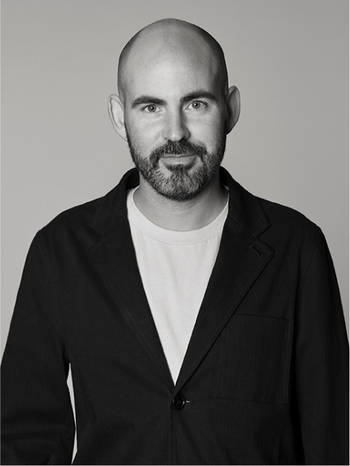Modern Art & Design Presents the Gunnar Asplund Family Collection
The Gunnar Asplund Family Collection
For this autumn's live auction Modern Art & Design, Bukowskis have been entrusted with selling significant objects from the Asplund family's private collection. It comprises twelve lots from three generations: the architects Gunnar Asplund and Hans Asplund, and the diplomat and UN ambassador Bo Asplund.
Gunnar Asplund (1885-1940) is considered one of the most significant and leading architects during the interwar period, both in Sweden and internationally. Asplund is seen as one of the foremost representatives of 1920s Nordic classicism, with the Skandia Theatre (1922) and the Stockholm Public Library (1928) as prominent examples. He was also one of the pioneers of functionalism, which he introduced in Sweden with the Stockholm Exhibition in 1930, where he was the chief architect.

Objects from the collection that come from Gunnar Asplund include a unique cabinet that he designed ca 1920 for his and his wife Gerda Sellman Asplund's private home at Mosebacke torg in Stockholm. It later accompanied them to Långängens gård in Stocksund, where the family relocated in 1927. According to family tradition, the cabinet was executed at the Nordiska Kompaniet workshops in Nyköping at the request of Asplund, and it is Gerda who modelled for the carved female figure.
The collection also offers a bronzed and gilded plaster model of Carl Milles’ "Angel of Death" that the sculptor conceived in 1921 for Asplund's Skogskapell (the Woodland Chapel) at Skogskyrkogården (the Woodland Cemetery) in Stockholm, and probably came into his possession in connection with the work on the Woodland Chapel. In addition, we find an important drop-leaf table veneered in sycamore and designed by architect colleague Carl Bergsten for the Stockholm Exhibition in 1930, as well as several catalogues and books with Asplund's ex libris stamp, including material relating to the Stockholm Exhibition in 1930 and an early edition of the German Bauhaus architect Walter Gropius' "Internationale Architektur ” from 1927 with a personal inscription from Gropius to Asplund.

Gunnar's son Hans Asplund (1921-1994) also became a prominent architect, involved with the United Nations architectural office in New York, the Kooperativa Förbundet's architectural office and Nordiska Kompaniet during the 1940s and 50s. The present collection includes two armchairs designed by Hans Asplund for Nordiska Kompaniet's beauty salon around 1955.
All objects have since passed by inheritance to Hans' son Bo Asplund (1950-2024), a prominent diplomat and UN ambassador with international missions that took both himself and the present collection around the world. The six birch chairs with webbing seats that were designed by his grandfather Gunnar for the Stockholm Public LIbrary have served Bo well over the years. The collection also includes a copy of the "Senna" chair, the original of which Gunnar designed for the Swedish pavilion at the Paris Exhibition in 1925. Italian producer Cassina made a very limited edition in 1983, and the present chair is reportedly the very first produced in this edition and sent as a gift from Cassina to Hans Asplund. When Cassina premiered the new edition in Copenhagen, Hans was present. The chair then had a prominent place in Hans and his wife Anne Asplund's home at Grönegatan 32 in Lund, and when Hans passed away in 1994 it passed on to Bo.

In the present sale and in addition to the collection, Bukowskis is pleased to present a table, a set of chairs and a ceiling lamp from Karlshamn Secondary School designed by Gunnar Asplund and erected between 1912-1918, as well as a set of eight chairs designed by Asplund for the Bredenberg department store in Stockholm around 1934-35.

The collection is being sold at Modern Art & Design
Catalogue online 5 November
Viewing 14–18 November, Berzelii Park 1, Stockholm
Live auction 19–20 November, Arsenalsgatan 2, Stockholm
Read more about Modern Art & Design
See the collection at Modern Art & Design

Hammer price
185 000 SEK
Estimate
50 000 - 75 000 SEK

Hammer price
440 000 SEK
Estimate
60 000 - 80 000 SEK

Hammer price
155 000 SEK
Estimate
80 000 - 100 000 SEK

Hammer price
16 000 SEK
Estimate
8 000 - 10 000 SEK

Hammer price
18 000 SEK
Estimate
8 000 - 10 000 SEK

Hammer price
1 800 SEK
Estimate
2 000 - 3 000 SEK

Hammer price
105 000 SEK
Estimate
60 000 - 80 000 SEK

Hammer price
44 000 SEK
Estimate
30 000 - 40 000 SEK

Hammer price
32 000 SEK
Estimate
30 000 - 40 000 SEK

Hammer price
105 000 SEK
Estimate
40 000 - 50 000 SEK
Requests & condition reports

Stockholm
Camilla Behrer
Head of Design/ Specialist Modern & Contemporary Decorative Art & Design
+46 (0)708 92 19 77

Stockholm
Eva Seeman
Chief Specialist Modern and Contemporary Decorative art and design
+46 (0)708 92 19 69

Stockholm
Jonatan Jahn
Head Specialist Contemporary and Modern Design
+46 (0)703 92 88 60

Stockholm
Karl Green
Specialist Modern and Contemporary Decorative Art & Design
+46 (0)700 07 94 25

























